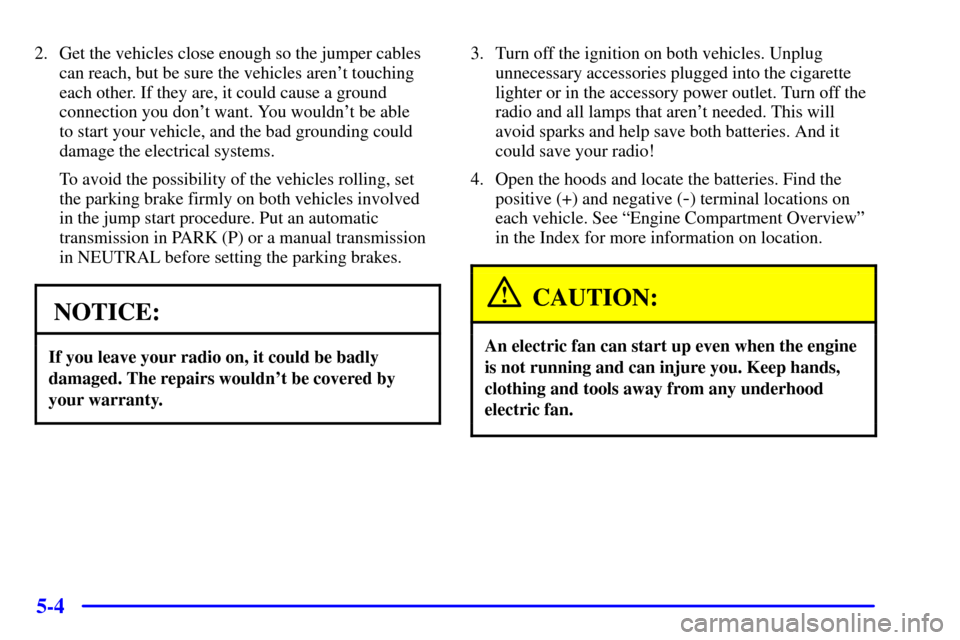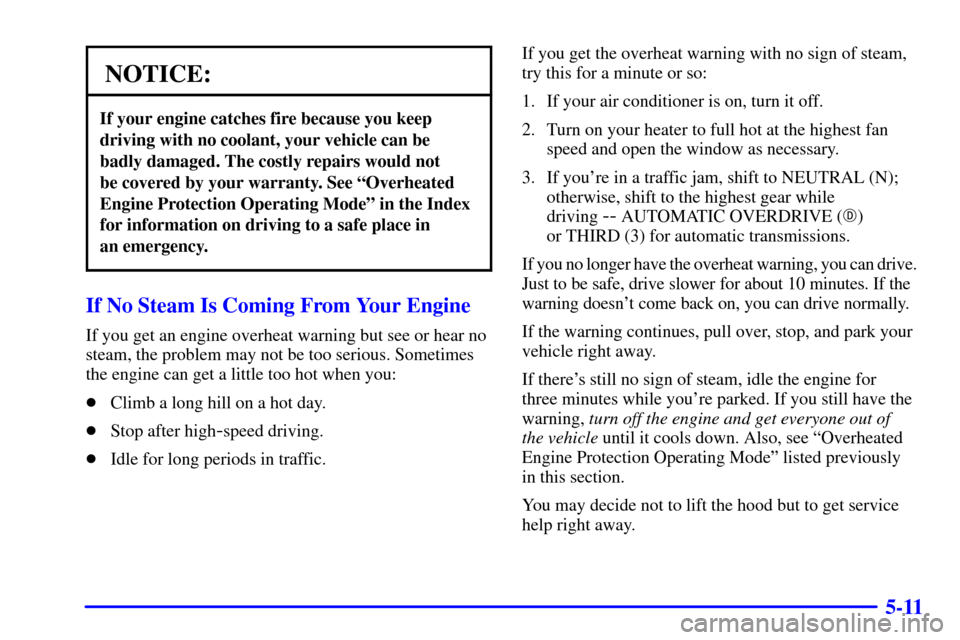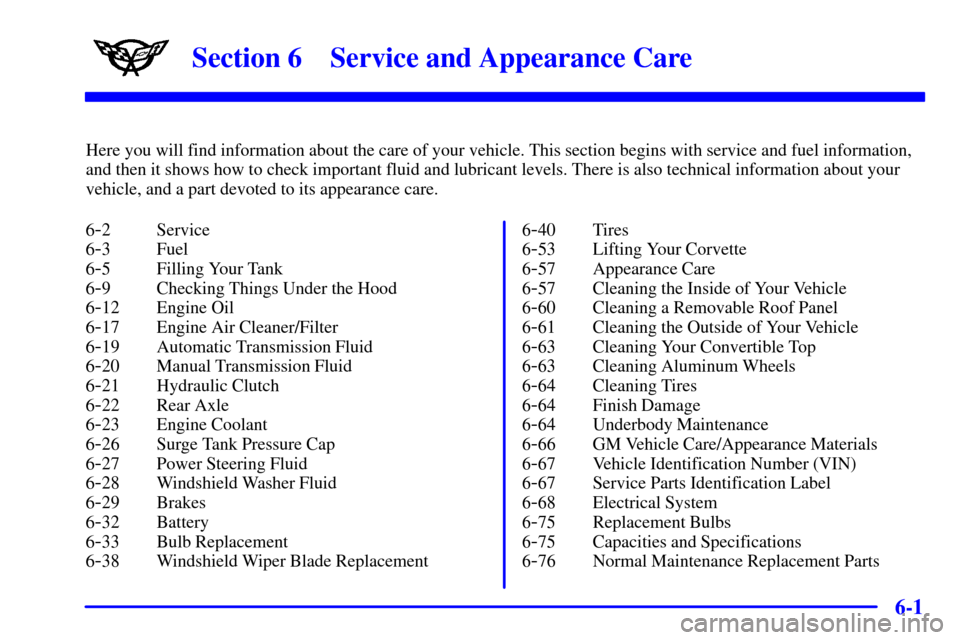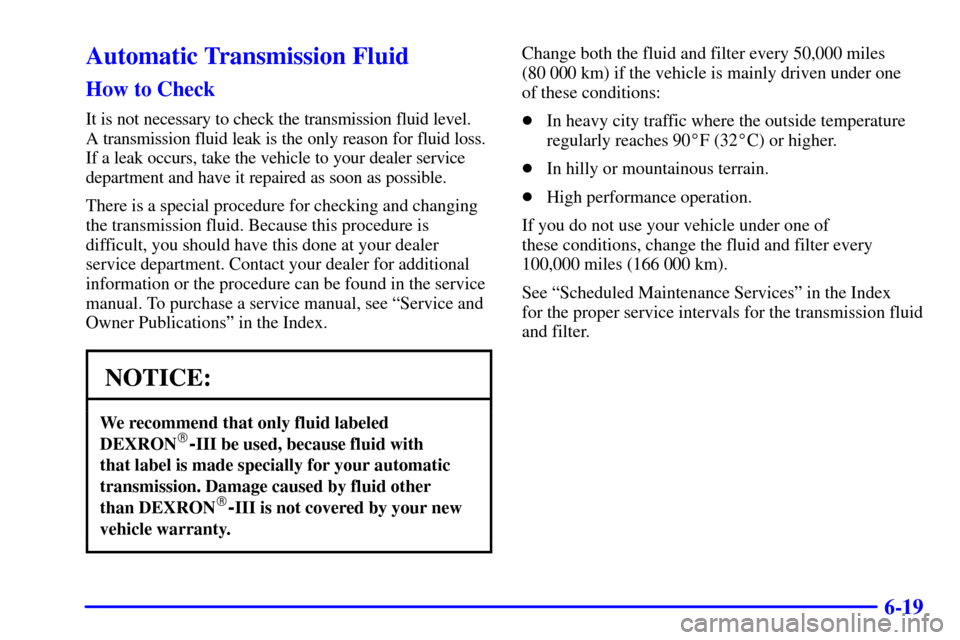Page 155 of 384
2-97
Press the GAGE button again to display the oil
temperature, such as:
�OIL TEMP 234 �F or
�OIL TEMP 112 �C
Press the GAGE button again to display the coolant
temperature, such as:
�COOLANT TEMP 123 �F or
�COOLANT TEMP 51 �C
Press the GAGE button again to display the automatic
transmission fluid temperature, such as:
�TRANS FLUID 123 �F or
�TRANS FLUID 51 �CPress the GAGE button again to display the battery
voltage, such as:
�BATTERY VOLTS 13.5
Press the GAGE button again to display the tire pressure
for the front tires (except Z06), such as:
�FRONT L34 R33 PSI or
�FRONT L234 R228 kPa
Press the GAGE button again to display the tire pressure
for the rear tires (except Z06), such as:
�REAR L34 R33 PSI or
�REAR L234 R228 kPa
Tire pressure is not available until the vehicle has
reached a speed of 15 mph (24 km/h) or more.
Page 160 of 384

2-102
Auto Lock
Press the OPTIONS button until AUTO LOCK appears
on the display, then use the RESET button to page
through the following choices:
�AUTO LOCK ON
�AUTO LOCK OFF
If you choose AUTO LOCK ON, both doors will
automatically lock when the vehicle exceeds 10 mph
(16 km/h) in a manual transmission. In a vehicle with
an automatic transmission, both doors will automatically
lock when you move the shift lever out of PARK (P).
Choose AUTO LOCK OFF to turn this option off.Auto Unlock
The AUTO UNLOCK will be available only if
AUTO LOCK is set to ON as described previously.
Press the OPTIONS button until AUTO UNLOCK
appears on the display, then use the RESET button
to page through the following choices:
�AUTO UNLOCK DRIVER
�AUTO UNLOCK BOTH
�AUTO UNLOCK OFF
If you choose AUTO UNLOCK DRIVER, the driver's
door will automatically unlock when you turn the
vehicle off and pull the key out of the ignition.
Choose AUTO UNLOCK BOTH, and both doors will
automatically unlock when you turn the vehicle off and
pull the key out of the ignition.
AUTO UNLOCK OFF turns off this option.
Page 168 of 384

2-110
HIGH TRANS TEMP (Automatic Transmission
Only): You will hear four chimes when this message
is displayed. To acknowledge this warning, press the
RESET button. After you press the RESET button,
the message will be displayed every 10 minutes until
the condition changes. If you do not press RESET,
the message remains on the display until the
condition changes.
If the transmission fluid temperature rises above 270�F
(132�C) or rises rapidly, this message is displayed.
The transmission may shift gears or apply the torque
converter clutch to reduce the fluid temperature.
Driving aggressively or driving on long hills can cause
the transmission fluid temperature to be higher than
normal. If this message appears, you may continue to
drive at a slower speed. You should also monitor the
transmission fluid temperature and allow it to cool to at
least 230�F (110�C). The transmission fluid temperature
can be monitored with the GAGES button on the DIC.
See ªAutomatic Transmission Fluidº in the Index.
You should also check the engine coolant temperature.
If it is also hot, see ªEngine Overheatingº in the Index.If the HIGH TRANS TEMP message is displayed during
normal vehicle operation on flat roads, your vehicle may
need service. See your dealer for an inspection.
SERVICE ACTIVE HANDLING: If the SERVICE
ACTIVE HNDLG message is displayed, there is a
problem with your Active Handling System and your
vehicle needs service. The instrument cluster light will
also be on and a chime will sound. When this message
is displayed, the system is not working. Adjust your
driving accordingly.
ACTIVE HANDLING: Your vehicle is equipped with
a computer controlled system to assist the driver in
controlling the vehicle in difficult driving conditions.
You may feel or hear the system working and see the
ACTIVE HANDLING message displayed in the DIC.
This is normal when the system is operating. Also see
ªAnti
-Lock Brakesº in the Index.
Page 172 of 384
2-114
Other Messages
Here are more messages that you can receive on your
Driver Information Center (DIC). To acknowledge a
message and read another message that may have
come on at the same time, press the RESET button.
�BRAKE BEFORE SHIFT
(Automatic Transmissions Only)
�CHANGE OIL NOW
(See ªGM Oil Life System�º in the Index.)
�CHANGE OIL SOON
(See ªGM Oil Life System�º in the Index.)
�CRUISE DISENGAGED
(See ªCruise Controlº in the Index.)
�CRUISE SET __ MPH (__ km/h)
(See ªCruise Controlº in the Index.)
�DOOR AJAR�ENGINE PROTECTION REDUCE ENGINE RPM
�HATCH AJAR (Coupe)
�HIGH VOLTAGE (See ªVoltmeterº in the Index.)
�LOW BRAKE FLUID
(See ªBrake Fluidº in the Index.)
�LOW FUEL (See ªFuel Gageº in the Index.)
�LOW VOLTAGE (See ªVoltmeterº in the Index.)
�LOW WASHER FLUID
(See ªWindshield Washer Fluidº in the Index.)
�RESERVE FUEL (See ªFuel Gageº in the Index.)
�TONNEAU AJAR (Convertible)
�TRUNK AJAR (Convertible/Z06)
�UPSHIFT NOW
(See ªManual Transmissionº in the Index.)
Page 249 of 384

5-4
2. Get the vehicles close enough so the jumper cables
can reach, but be sure the vehicles aren't touching
each other. If they are, it could cause a ground
connection you don't want. You wouldn't be able
to start your vehicle, and the bad grounding could
damage the electrical systems.
To avoid the possibility of the vehicles rolling, set
the parking brake firmly on both vehicles involved
in the jump start procedure. Put an automatic
transmission in PARK (P) or a manual transmission
in NEUTRAL before setting the parking brakes.
NOTICE:
If you leave your radio on, it could be badly
damaged. The repairs wouldn't be covered by
your warranty.
3. Turn off the ignition on both vehicles. Unplug
unnecessary accessories plugged into the cigarette
lighter or in the accessory power outlet. Turn off the
radio and all lamps that aren't needed. This will
avoid sparks and help save both batteries. And it
could save your radio!
4. Open the hoods and locate the batteries. Find the
positive (+) and negative (
-) terminal locations on
each vehicle. See ªEngine Compartment Overviewº
in the Index for more information on location.
CAUTION:
An electric fan can start up even when the engine
is not running and can injure you. Keep hands,
clothing and tools away from any underhood
electric fan.
Page 256 of 384

5-11
NOTICE:
If your engine catches fire because you keep
driving with no coolant, your vehicle can be
badly damaged. The costly repairs would not
be covered by your warranty. See ªOverheated
Engine Protection Operating Modeº in the Index
for information on driving to a safe place in
an emergency.
If No Steam Is Coming From Your Engine
If you get an engine overheat warning but see or hear no
steam, the problem may not be too serious. Sometimes
the engine can get a little too hot when you:
�Climb a long hill on a hot day.
�Stop after high
-speed driving.
�Idle for long periods in traffic.If you get the overheat warning with no sign of steam,
try this for a minute or so:
1. If your air conditioner is on, turn it off.
2. Turn on your heater to full hot at the highest fan
speed and open the window as necessary.
3. If you're in a traffic jam, shift to NEUTRAL (N);
otherwise, shift to the highest gear while
driving
-- AUTOMATIC OVERDRIVE (�)
or THIRD (3) for automatic transmissions.
If you no longer have the overheat warning, you can drive.
Just to be safe, drive slower for about 10 minutes. If the
warning doesn't come back on, you can drive normally.
If the warning continues, pull over, stop, and park your
vehicle right away.
If there's still no sign of steam, idle the engine for
three minutes while you're parked. If you still have the
warning, turn off the engine and get everyone out of
the vehicle until it cools down. Also, see ªOverheated
Engine Protection Operating Modeº listed previously
in this section.
You may decide not to lift the hood but to get service
help right away.
Page 273 of 384

6-
6-1
Section 6 Service and Appearance Care
Here you will find information about the care of your vehicle. This section begins with service and fuel information,
and then it shows how to check important fluid and lubricant levels. There is also technical information about your
vehicle, and a part devoted to its appearance care.
6
-2 Service
6
-3 Fuel
6
-5 Filling Your Tank
6
-9 Checking Things Under the Hood
6
-12 Engine Oil
6
-17 Engine Air Cleaner/Filter
6
-19 Automatic Transmission Fluid
6
-20 Manual Transmission Fluid
6
-21 Hydraulic Clutch
6
-22 Rear Axle
6
-23 Engine Coolant
6
-26 Surge Tank Pressure Cap
6
-27 Power Steering Fluid
6
-28 Windshield Washer Fluid
6
-29 Brakes
6
-32 Battery
6
-33 Bulb Replacement
6
-38 Windshield Wiper Blade Replacement6
-40 Tires
6
-53 Lifting Your Corvette
6
-57 Appearance Care
6
-57 Cleaning the Inside of Your Vehicle
6
-60 Cleaning a Removable Roof Panel
6
-61 Cleaning the Outside of Your Vehicle
6
-63 Cleaning Your Convertible Top
6
-63 Cleaning Aluminum Wheels
6
-64 Cleaning Tires
6
-64 Finish Damage
6
-64 Underbody Maintenance
6
-66 GM Vehicle Care/Appearance Materials
6
-67 Vehicle Identification Number (VIN)
6
-67 Service Parts Identification Label
6
-68 Electrical System
6
-75 Replacement Bulbs
6
-75 Capacities and Specifications
6
-76 Normal Maintenance Replacement Parts
Page 291 of 384

6-19
Automatic Transmission Fluid
How to Check
It is not necessary to check the transmission fluid level.
A transmission fluid leak is the only reason for fluid loss.
If a leak occurs, take the vehicle to your dealer service
department and have it repaired as soon as possible.
There is a special procedure for checking and changing
the transmission fluid. Because this procedure is
difficult, you should have this done at your dealer
service department. Contact your dealer for additional
information or the procedure can be found in the service
manual. To purchase a service manual, see ªService and
Owner Publicationsº in the Index.
NOTICE:
We recommend that only fluid labeled
DEXRON�-III be used, because fluid with
that label is made specially for your automatic
transmission. Damage caused by fluid other
than DEXRON
�-III is not covered by your new
vehicle warranty.
Change both the fluid and filter every 50,000 miles
(80 000 km) if the vehicle is mainly driven under one
of these conditions:
�In heavy city traffic where the outside temperature
regularly reaches 90�F (32�C) or higher.
�In hilly or mountainous terrain.
�High performance operation.
If you do not use your vehicle under one of
these conditions, change the fluid and filter every
100,000 miles (166 000 km).
See ªScheduled Maintenance Servicesº in the Index
for the proper service intervals for the transmission fluid
and filter.